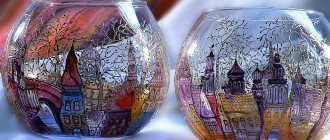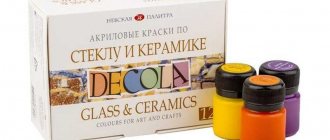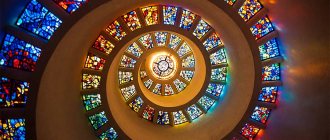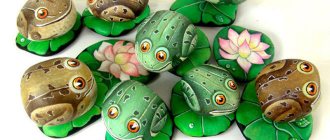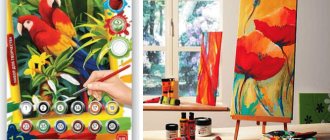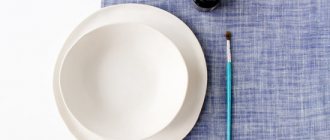How to prepare the surface?
Before applying stained glass paints to glass, mirrors or ceramics, the surface must be washed and degreased so that the paint adheres better, the adhesion to the glass is better, and... the stained glass paint does not peel off in the future.
Any detergent is suitable for washing. You can degrease it with alcohol or glass cleaner. The second option is used much more often, especially if the surface is large and flat.
You can degrease glass with glass cleaner.
Everyone knows that our skin secretes sebum, and on the palms of the hands and soles of the feet, it is produced especially intensively... By the way, this is why fingerprints are clearly visible on glass and metal. It is necessary to degrease the glass from sebum!
During operation, it is advisable not to touch the surface of the glass with your hands, so as not to leave fingerprints or palm prints. You can put, for example, a paper napkin under your hand. Very comfortably…
How to paint with stained glass paints on glass: pipette or brush?
The beauty of stained glass paints is that they can be applied not only with a brush, but also with a pipette, which depends on the base of the material and the height of the paint.
With a pipette, for example, it is convenient to fill large spaces, and then use a brush to distribute the paint over the surface. At least that's how I work... I got the hang of it and the work goes faster and more interesting! The surface is even, smooth, just like real colored glass! But mostly, stained glass artists work with a brush.
In the photo I am pouring paint with a special pipette, but you can take a regular pipette from the pharmacy
It all depends on the final result that you want to see at the end of the work. It’s up to you to decide whether to choose a brush or a pipette... In any case, you need to try both to understand what works best for you!
If you are a beginner, then it will be useful for you to know that stained glass paints come in different bases. And before you go to the store and make a choice, it would be nice to figure out what and how.
DIY stained glass paints. Glass painting with stained glass paints
Various hand-made techniques are becoming more and more popular every year. That is why today you can find a lot of videos and step-by-step master classes explaining what you can do with your own hands. This includes modeling from clay and plasticine, making figures from paper, papier-mâché, drawing, cutting, origami, etc. Glass painting is also considered one of the varieties of such handicraft. You can make stained glass paints yourself. What is this art? What can auxiliary materials for it be made from and how to paint glassware correctly?
What are the advantages of stained glass painting?
The main advantage of stained glass painting, like any other decorative and applied art, is the opportunity to make an exclusive designer item yourself. Stained glass paints allow you to update your home interior and add a fresh touch to it. For example, you can use them to decorate a mirror in a hallway or bedroom, decorate glass parts of doors, paint chandelier shades, and dishes.
In addition, stained glass painting allows you to create spectacular photo frames and other products, which, if the opportunity arises, can be given to your friends and acquaintances. This is a great and original gift.
What tools are used to paint on glass?
Usually, for creativity, a master who is engaged in stained glass craftsmanship needs a whole set of various auxiliary tools. It can be:
- brushes of different sizes and thicknesses;
- contours and patterns;
- pigments and glitters (decorative sparkles, resistant to water);
- art gels;
- thinners;
- acrylic paints;
- structural pastes and varnishes;
- palette knife (a small tool with a pointed spatula at the end), etc.
What is stained glass paint used for?
And, of course, stained glass paints play an important role in this type of art. These are, as a rule, liquid-type materials. They are bright and fit well on glass. They are most often used to create floral patterns. But, unlike the acrylic base, they tend to spread, which is why they are used in tandem with a special contour. When applied to a glass surface, this paint dries quickly and hardens.
In addition, stained glass paint can be used to create a variety of products that require additional firing in a kiln.
How to make paints from PVA glue and food coloring?
You can purchase all the materials for applying designs on glass in online stores and specialized stores (where they sell a variety of paraphernalia for creativity). If you wish, you can make stained glass paints with your own hands. The easiest way is to prepare a coloring base from ordinary food coloring and PVA glue. How to do it?
Take a small shallow container (you can use a regular plate or plastic jar lid) and pour about 2 teaspoons of glue into it. Add a couple of drops of liquid dye here, for example red (food grade is suitable), and stir. Make other colors in the same way, and then you can immediately apply them by dipping the brush. It is noteworthy that such painting on glass with stained glass paints, due to the adhesive base, easily turns into a kind of sticker. Such designs are easy to remove.
Interestingly, using the resulting paints you can paint not only on glass, but also on files and oilcloth surfaces, from which you can also easily remove an image.
How to make paints from glue and pen refills?
In a similar way, you can make stained glass paints with your own hands using the already familiar PVA glue and a gel pen refill (choose the color as needed). Squeeze out a small portion of glue into a container (you can take an empty glue or paint bottle), then the contents of the rod, and then more glue. Mix the resulting contents until the color is uniform - and the stained glass materials are ready for use. Now you can create any designs on glass.
Note: since the set of stained glass paints is homemade, their consistency will be much thinner than that of factory ones. To eliminate this drawback, you must first let each of the applied layers dry. Or you can add a pinch of loose glitter or eye shadow for thickness.
How to make stained glass paints from solvent and glue?
In addition to simple options for preparing paints, there are also more complex ones, which include a larger number of components. To do this, you will need ordinary glassware (for greater convenience, you can take baby food jars). Next you need to take the following components:
- nitrovarnish NC (218, 222 or 2141);
- paint thinner (647 will do);
- set of oil paints.
Let's say you take a glass jar of baby juice or puree. Carefully pour in 1/3 of the nitro varnish, add a little solvent to it and stir until a homogeneous liquid mass is formed. Carefully squeeze the contents of one of the paint tubes into it and mix.
The result is a medium-density mass that can be easily applied to any glass base.
How to make paints from glue and acetone?
In addition to these options, painting on glass with stained glass paints can also be done using other materials. So, for a new bottle of homemade paint you will need:
- 1 bottle of BF-2 glue;
- 1 bottle of acetone;
- 1 any soluble paint.
Take a glass container, for example a jar, and carefully pour glue into it. Then we dilute it (in a 1:1 ratio) with acetone, add a color base and re-mix future stained glass paints with glue.
How to make paints from gelatin and dyes?
One of the simplest and most inexpensive methods for obtaining paints for stained glass painting is mixing gelatin, water and fabric dyes. It consists of the following: first, gelatin is taken (you only need 6 g), then it is poured into warm water (until it swells). Afterwards, dry dyes are diluted with water in a separate jar and mixed with gelatin. The paint is ready. Ready-made stained glass paints for glass are applied to the glass surface and coated with nitro varnish for greater reliability.
How to paint a glass surface correctly?
In order for your work to be beautiful and colorful, you must follow the rules of drawing on glass. So, first you should prepare the following materials:
- special marker for glass;
- contours;
- palette for diluting paints;
- a cone-shaped tip (helps make the lines in the drawing thin and even);
- cotton swabs and disks (with their help you can remove small and large imperfections in the image);
- thinners;
- a needle (will help eliminate paint bubbles that periodically form in the drawing);
- thin and thick brushes;
- cloth or sponge;
- paints;
- lined tablet for creating a primary sketch.
When all these materials and accessories are ready, you can begin painting with stained glass paints. So, at the first stage, it is recommended to make a sketch (to do this, we place a stencil under the glass surface), transfer it to the glass using a marker, and then outline the resulting picture. After this, we leave the sketch picture for 20-30 minutes and begin painting with paints.
At the next stage, we begin to paint the resulting blank on the glass. To do this, it makes sense to choose some “reporting point”, for example, it could be the ear in the portrait. And then from this point it will be possible to move on to other details of the picture, painting the sketch from section to section.
In order for painting with stained glass paints to “take up” well, you need to leave the completed drawing for 3-4 hours. After this time, try to touch the picture you created. It should be smooth and the paint should stick to your hands.
What objects can be painted with paints?
Painting opens up unlimited possibilities for creative people who are interested in it. And the whole point is that a variety of things can act as objects for decoration. For example, since ancient times, in churches and cathedrals, stained glass paints were used to decorate the windows and ceilings of monasteries, castles, houses of rich gentlemen, libraries, etc.
In addition, today it is becoming fashionable to paint doors and glass decorative partitions, which are often used for zoning living spaces. Vases painted with stained glass paints also look original, as do paintings, glasses and glasses, dishes, candlesticks, candles, cups and mirrors, jars, flasks, etc.
What to consider when painting on glass?
In the process of painting with paints, you may encounter various working issues, which is why it is so important to know some of the subtleties of stained glass art. For example, for convenience, it is better to place glass on a table or any other horizontal plane. When working with small objects, you must first place a terry towel on the work surface. To degrease, the base can be wiped with alcohol or a regular soap solution.
In short, if you want to make the perfect piece of art, first do the preparatory work (including preparing the paints) and then get to work.
Sources: https://pikabu.ru/story/vitrazhnaya_rospis_materialyi_i_vsyo_neobkhodimoe_4206760 https://www.syl.ru/article/179693/new_vitrajnyie-kraski-svoimi-rukami-rospis-po-steklu-vitrajnyimi-kraskami https://kraska. guru/kraski/vidy/po-steklu.html
Is the circuit required or not?
Typically, classic painted stained glass or glass paintings have outlines. If your goal is beautiful, smooth murals, use raised paint or stained glass lead tape.
Remember: all contour lines must be closed. If there is a break somewhere in the outline, the colors will flow, mix, and this can ruin your work.
Most often they use a black outline or a tin color that imitates metal.
Unless, of course, this is a contourless technique, where the contour is not used to contain stained glass paint, but rather is of a decorative nature. In another article, you can read all about the most popular stained glass painting techniques
And of course, each manufacturer has its own contour paints in tubes of different colors. I especially like the ones that imitate silver or gold.
The golden outline looks great in subject paintings on glass
Be sure to let the relief outline dry for about 20 minutes before you start painting with stained glass paints! Take this into account! When working with stained glass paints, the sequence of actions one after another is important.
Features of applying stained glass paint
To work with stained glass paints, it is important to stock up on a number of useful tools. To begin with, it is better to use non-burning paints. Plus, small brushes with hard bristles. Some people prefer to use a sponge. A solvent will help remove unnecessary marks. To work, you need to purchase contour paints that will help preserve the outlines of the pattern and prevent the main compositions from mixing.
To work, you need to purchase contour paints that will help preserve the outlines of the pattern and prevent the main compositions from mixing.
Stages of painting with stained glass paints
Before starting work, it is important to determine the design of the pattern. It is better to make a sketch like a stencil, attaching it to the inside of the surface to be treated, and outline its boundaries on the outside with a marker or felt-tip pen.
Before decorating, the surface is degreased.
- Stained glass paints for contours should be applied carefully, avoiding smearing and spreading of paint. It should dry well. The drying time is usually indicated by the manufacturer on the packaging.
- Next comes the painting itself with a brush or sponge. The resulting voids at the boundaries of the contour can be painted over with a second layer. The paint is applied directly to the area to be painted and then rubbed.
- If you paint with acrylic paints, then the presence of contours is not necessary. If desired, it can be applied, then the entire pattern will resemble a stained glass window, but without outlines it is more like painting on glass.
- If it is necessary to paint large areas, aerosol cans are used. They can be oil-based, latex-based, acrylic-based or heat-resistant. Acrylic compositions are popular.
Such sprays have good adhesion to the surface, covering even hard-to-reach places. Do not require additional devices for application. They dry quickly and are available in a variety of colors. Professionals often use aerosols to draw small details. It all depends on experience and dexterity. Among the tangible disadvantages is the inability to dilute the composition. In addition, colors cannot be mixed. And the presence of auxiliary sketches increases paint consumption.
Before starting work, it is important to determine the design of the pattern.
How to paint with stained glass paints?
Pouring paint and filling in the elements in stained glass painting is perhaps the most interesting part. You need to start filling each sector from the core, gradually painting the areas next to the outline. At the same time, it is not advisable to “climb” onto the contour itself, otherwise the painting will look sloppy and not so impressive.
You can start learning to paint with large flower buds
The background can be painted last. But there are other options for painted glass paintings, where the main background consists of acrylic paint and... newspaper! This decorative design of a glass picture looks harmonious in an ensemble with stained glass varnish paints!
Especially for lovers of stained glass painting, I develop and record Master classes in video format. One of these lessons may be suitable even for beginners, since it is “chewed” in detail and will be understandable to everyone. It is also ideal for those who want to enjoy a quiet lesson as Art Therapy for relaxation and calm.
Acrylic paint and its features
Acrylic paints are a mixture, the main active component of which is acrylic itself. It is referred to as a polymeric substance formed during the breakdown of acid. To create such a composition, ethanol and chloroform are used in strict proportions. As a result of the connection, a transparent substance is obtained, after which a pigment of the desired shade is added to it.
Acrylic paints frozen on the surface of the palette Source accorel.ru
How to correct defects and remove stained glass paints from glass?
A novice artist almost always encounters problems when working with stained glass paints: he accidentally “blurs out” more material, paints over the outline, creates bubbles... These defects need to be corrected immediately, before the paint dries.
Bubbles, for example, can be conveniently “expelled” to the contour, or “burst” with a needle or toothpick. And excess paint can be removed with a brush or cotton swab.
Paint that has leaked beyond the contour can be removed with a clean brush dipped in solvent.
It is convenient to clean an accidentally painted outline with a brush or stick dipped in solvent or water (depending on the base of the stained glass paint). Using a solvent can completely remove stained glass paints from glass before they dry.
Stained glass paints for working on glass surfaces:
It is recommended to use special materials for painting on glass surfaces.
Features of the material
Stained glass paints are special types of paints and varnishes that are intended for application to smooth surfaces. With their help you can realize the most daring ideas. Such materials are suitable for adults and children.
At the same time, dyes differ in composition, which allows you to choose the optimal substances. Paints can be water-based, alcohol-based or varnish-based. Depending on this, the technology for applying the pattern differs.
Scope of application
Stained glass dyes can be used for painting ordinary glassware. They can also be used to paint mirrors or glass. With the help of such materials it is possible to create vintage or modern design items. They easily withstand exposure to ultraviolet radiation and are resistant to abrasion.
Pros and cons of the material
The advantages and disadvantages of materials depend on the composition of the dyes. Thus, acrylic paints that are water-based have the following advantages:
- quick drying - they stop sticking after 3-4 hours, and dry completely after a day;
- water resistance;
- possibility of fixing by heating in the oven;
- ease of mixing compositions.
However, the material also has some disadvantages:
- not too bright shades;
- risk of scratches without firing;
- thick consistency - this makes it impossible to use dyes for large fills;
- risk of deviation from the contour.
6.How to dilute stained glass paints if they have thickened?
Remember: if your working material has thickened, you can only dilute it with a special thinner, preferably from the same company as the paints! Why?
If you dilute water-based stained glass paints with water, they will fade after drying. The same thing happens with organic paints. White Spirit “kills” varnish-based paints.
The wrong thinner will impair adhesion to the surface, reduce UV resistance, gloss and original shade.
Purity and transparency of color are the main indicators of stained glass paints
To ensure that the finished painting does not fade or become cloudy, and that the paints do not change their composition and properties, use special thinners designed for these purposes! Every paint manufacturer has them!
Many stained glass works have been ruined when artists did not dilute thickened stained glass paints correctly.
How to thin construction acrylic paint before use
In order to be able to use construction acrylic paint, it must be given the correct consistency. This is true in cases where it has been sitting at home for some time after purchase. You can prepare the composition for finishing work in one of the following ways:
- It is necessary to dilute the paint and water in a ratio of 1: 1. This will enable the paintwork material (paint and varnish material) to lie more evenly on the surface and retain its properties.
- Make the composition in a ratio of 1:2. This consistency is also easy to work with. Paint diluted in this way will thoroughly saturate the roller and lie evenly on the surface.
- Prepare a composition of 1: 5. This way the product is too liquid, which allows you to get slightly visible pigmentation. Using this kind of consistency, defects on the surface are removed and textured details are processed.
Important! Less commonly, a composition of 1:15 is created. It is used only to implement a gradient effect in order to create a smooth transition from one shade to another. Found in modern interior styles.
Interior acrylic paint Source onlinetrade.ru
How to mix stained glass paints and get new shades?
Unfortunately, not all manufacturers of stained glass paints have such a large selection of paints as the French Pebeo Vitrail, for example. Don't despair, because paints can be mixed to get the desired shade!
To obtain new colors and shades, use a special container with indentations. Although you can get by with regular plastic bottle caps and other available containers.
Old cream jars make excellent containers for mixing paints.
Start mixing with a small amount of paint... it is important to remember that dark colors are easier to create than light colors. In any case, knowledge and skills come with practice. Try mixing and creating your own interesting colors and shades!
Differences between fired and unfired stained glass paints
Fired and non-fired paints differ in subsequent processing. In addition, the material, which does not require additional heat treatment, is easier to use. Therefore, “unfired” paints are optimal for novice decorative artists, as well as when beautiful glass framing is required.
For buyers, there is a hint on the cans with paintwork materials. So, on packages (jars) with “fired” paint there is the inscription “Porcelain” or “Porzellan”. The average firing temperature ranges from 120 to 160 degrees, and the time from half an hour to one and a half hours. The painted product is placed in a cold oven and only then the temperature is brought to the required degrees.
When using paints that require contours, it is important to remember that the contour must also be fired.
“Unfired” compositions have a more saturated, bright color. However, their drying time reaches three weeks and only after a month can the painted surface be washed.
The painted product is placed in a cold oven and only then the temperature is brought to the required degrees.
Why shouldn't you touch the surface of varnish-based paint?
If you have made your choice in favor of stained glass varnish paints , you need to remember one rule as an axiom: solvent-based stained glass paints take a long time to dry!
Any touch in the first 30-40 minutes will leave a fingerprint. Complete drying occurs after 8 hours or more (the manufacturer indicates the exact time on the jar). It is not recommended to force stained glass paints to dry, as this will cause them to lose their shine.
Also, keep your work to dry completely in a place where dust will not get in... otherwise you will end up with a “dusty decor” on the surface of the glass

